2016 Polaris 800 SKS 155 Review
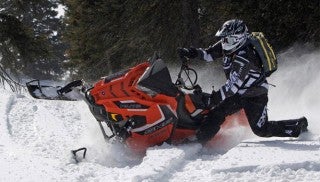
SKS nearly matches the Pro-RMK in steep-and-deep fun
It is quite possibly the best sleeper mountain snowmobile on the market for this upcoming season. Polaris’ SKS and Pro-RMK are two of the finest mountain snowmobiles we’ve pushed and squeezed this past March during our testing season; and it is the full-meal-deal SKS that painted a thief-in-the-night grin on our faces.
Sure, attention flows to Polaris’ RMK Pro 155 and 163. Sure, the Pro is worthy of Here-Comes-The-King adoration. Even we’re guilty of that. But hidden deep in our trove of What-about-that-one comes our nod-and-wink toward the SKS. We can write down similar adverbs and adjectives to describe the SKS as we have written of the RMK Pro.
So, who wants the SKS? We do and you should, too. Why? To save a few bucks for those aftermarket skis, a turbocharger, several more trips to the backcountry, or to pay a fine, if you should just wander into some out-of-bounds country – as we have.
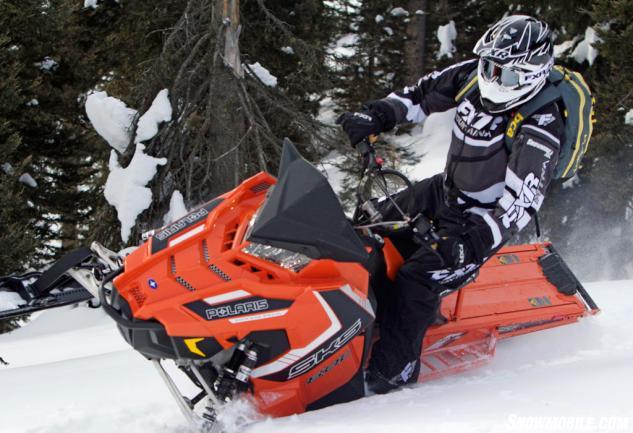 Is this an SKS or Pro-RMK? Yes, it is an SKS in a brilliant-and-bold color, and loaded with enough Pro-RMK options that we began calling it an SKS Pro.
Is this an SKS or Pro-RMK? Yes, it is an SKS in a brilliant-and-bold color, and loaded with enough Pro-RMK options that we began calling it an SKS Pro.Just to be clear here, returning to Polaris’s line is the RMK – the standard RMK from 2015 that rides on Polaris’ original Pro-Ride chassis. The returning RMK for 2016 is not an AXYS Pro-RMK, as the moniker “Pro-RMK” is reserved for the AXYS RMK. The RMK comes in as an 800 or 600, with the 800 in 155 and 144 lengths, and the 600 as a 144 only. These are chaincase RMKs. The 800 RMK uses the Cleanfire 800 motor from 2015 and back, not the H.O. 800.
The 2016 AXYS SKS – Snow King Special – returns to Polaris as a fresh way to differentiate the two deep-powder models. The AXYS Pro-RMK is Polaris’ premium deep-powder go toy. We suppose in the future, the SKS will replace the standard Pro-Ride RMK.
COMPARISON: Read our review of the 2016 Ski-Doo Summit X T3 154
Early Spring-buy purchasers were able to load up their soon-to-own 2016 SKS similar to that of a Pro-RMK, making their SKS nearly equal to that of a Pro-RMK. Amenities include ice-scratchers, premium interactive instrument pod, high-end Walker Evans piggyback clicker shocks, color-matching front bumper and ski hoops, varied-height Pro Taper handlebars (three height choices to choose), Burandt bags, and the Series 6.0, 2.6-inch mountain paddle-track, to name some popular add-ons. Those who loaded up their Spring-buy 2016 SKS lovingly called their SKS the “SKS Pro.” And rightfully so.
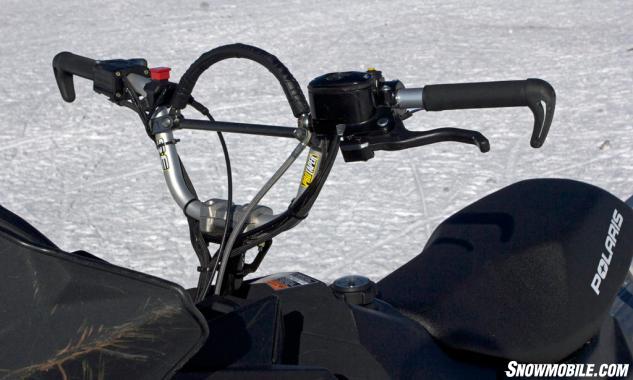 The SKS comes standard with Pro Taper handlebars. An in-season SKS will receive the tallest bars with mountain strap. Spring-buy purchasers were able to choose, low, mid-height and tall ProTaper bars.
The SKS comes standard with Pro Taper handlebars. An in-season SKS will receive the tallest bars with mountain strap. Spring-buy purchasers were able to choose, low, mid-height and tall ProTaper bars.Regardless of added Spring-buy wizardry and bling, the 2016 SKS comes equipped with the patented Raised AXYS RMK Chassis and new 800 Cleanfire H.O. engine. Sweet.
Let’s breakdown the 2016 SKS further. The Cleanfire H.O. 800 motor has two, three-stage electronically-controlled exhaust valves, lightweight crankshaft (to reduce rotating mass), electronic oil pump, and V-Force reeds on the intake – same as the Pro-RMK.
Standard track on the SKS is the tried-and-true Series 5.1 deep powder track. But the Series 6.0 track could be added as a Spring-buy option. The lighter and taller-lugged Series 6.0 track is our recommendation. The SKS line comes with a lightweight chaincase – no Quick Drive belt drive system is available. But not to worry; the race-ready RMK Assault uses the chaincase system as well as the Pro-RMK 155 and 163 with Series 7.0 track – the track with three-inch tall lugs. Be aware, the SKS comes in one track length only, 155. There is no 144 or 163 SKS on the dinner table.
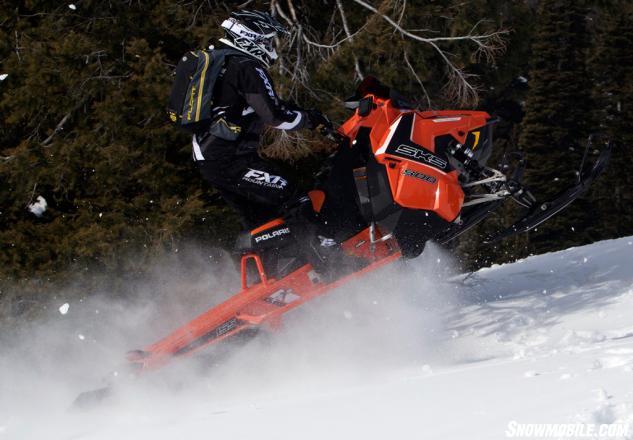 The raised/lifted AXYS platform and cinched in panels make the 2016 SKS skinny in the trees and on mountain sides. The SKS is 35-pounds heavier than the RMK Pro, but the SKS is a climate-change-denier; it doesn’t care whose climate it is in.
The raised/lifted AXYS platform and cinched in panels make the 2016 SKS skinny in the trees and on mountain sides. The SKS is 35-pounds heavier than the RMK Pro, but the SKS is a climate-change-denier; it doesn’t care whose climate it is in.The 2016 SKS shares the same rear suspension and front suspension as the AXYS Pro-RMK. However, on the skidframe, the SKS uses idler wheels – more than the Pro-RMK uses, where it uses ice-scratchers for hyfax cooling and lubrication. Polaris figures some rental shops will purchase and rent out the SKS; idler wheels protect the track and the RMK Coil-Over rear suspension. Furthermore, the SKS has an additional engine heat exchanger/cooler behind the bulkhead and up above the track drivers. This too adds a level of protection to assure the engine temperature remains cool on hard-packed trails. The SKS has the same laser cut rails as the RMK Pro.
COMPARISON: Read our review of the 2014 Polaris 800 Pro-RMK + Video
Up front, the SKS rides on the same tall forged aluminum A-arms as the Pro-RMK. Forging is a process where aluminum is beat into the needed shape. Casting, as you can imagine, is pouring hot molten aluminum into a mold to produce the parts. Forging produces stronger (than cast), but lighter components. As we wrote in our article on the Pro-RMK, the forged A-arms have bend points that absorb impact energy, rather than sending said energy to the tunnel, causing it to wrinkle. Wrinkled or bent tunnels are tunnels your insurance representative says, “Replace.”
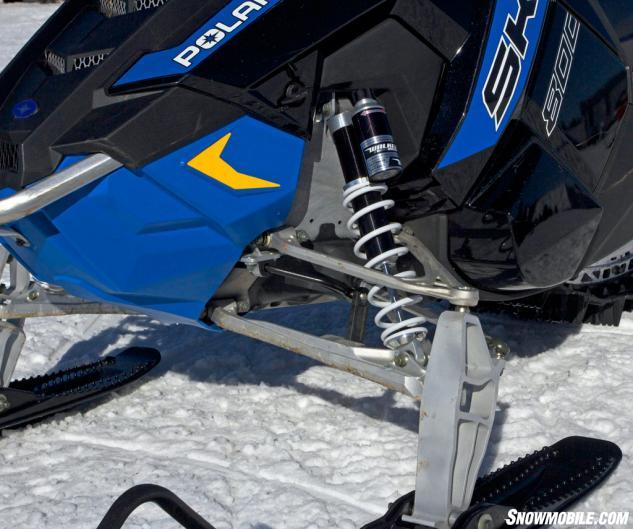 Forged aluminum A-arms are strong, light and are designed to absorb impact energy from blunt force trauma, rather than sending said energy to the tunnel. This protects the tunnel from bending and wrinkling.
Forged aluminum A-arms are strong, light and are designed to absorb impact energy from blunt force trauma, rather than sending said energy to the tunnel. This protects the tunnel from bending and wrinkling.The SKS also comes standard with PowderTrac runningboards, Pro-Lite seat and bright LED headlamps. Skis are the Gripper ski. Front-end ski width is an adjustable 39, 40, and 41 inches.
Given all the above, what did we learn about the SKS? For starters, we were handed, as we call it, an SKS “Pro” (our definition); it was an SKS with much Pro-RMK sugar. It had the Series 6.0 track, interactive display, mid-height Pro Taper handlebars with mountain strap and premium Walker Evans piggyback clicker shocks. We were wooed by it. The modern SKS tapped into our 1990-something memories when we beat the mountains in Island Park, Idaho on Indy 500 SKSs. My, my how far Polaris has come.
Did we feel the SKS was less than AXYS RMK? Heck no. For starters, the estimated dry weight for the 155 SKS is 443 pounds (with Series 5.1 track), and even a few pounds lighter if it spins the Series 6.0 track. This makes the SKS right on par with the other ultra-light, high-end premium mountain snowmobiles of similar track length such as Ski-Doo’s XM Summit X T3 and Arctic Cat M8000 Limited. What does that mean? Polaris’ middleweight mountain snowmobile is as light as Doo’s and Cat’s featherweight – and cheaper to purchase.
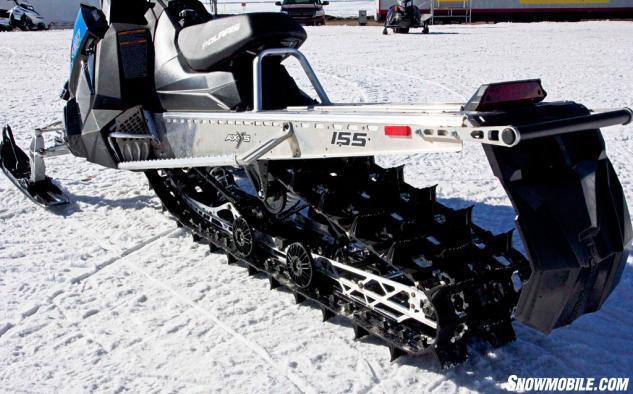 Standard track on the SKS 155 is the Series 5.1 powder track that has 2.4-inch tall lugs; the same track Polaris’ used on its Pro-Ride RMK Pro; it remains a good track. Note the PowderTrac runningboards and ProLite seat.
Standard track on the SKS 155 is the Series 5.1 powder track that has 2.4-inch tall lugs; the same track Polaris’ used on its Pro-Ride RMK Pro; it remains a good track. Note the PowderTrac runningboards and ProLite seat.On the snow during our testing season – the snow not being deep powder, but Spring-like hardpacked snow – the SKS felt as light as the Pro-RMK with its raised and narrowed chassis. It managed the additional 35 pounds with ease. Give credit to the High Output 800 motor.
COMPARISON: Read our review of the 2016 Arctic Cat M8000 Limited + Video
In its middle ski-stance, test rider Kevin Allred was able to take the 2016 SKS through narrow tree stands and across the steepest slopes. He said he did not notice the weight. Furthermore, he often said the chaincase was as responsive as the Quick Drive. We figured it would be, as chaincase systems are reliable and well-proven.
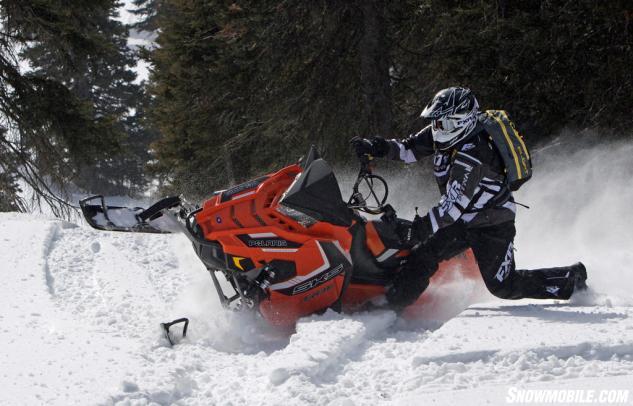 Feel like carving on a dime and getting change back? Then the AXYS SKS 155 will do just that.
Feel like carving on a dime and getting change back? Then the AXYS SKS 155 will do just that.As we took to writing this story, we priced-out on Polaris’ website the cost to build an SKS with as many Pro-RMK components as possible. We found the SKS as expensive as the Pro-RMK, so back to our thoughts about on saving money. The 2016 SKS is what it is. The money savings will come in purchasing an SKS as is, with the recommendation to install the Series 6.0 track. Removing bogey wheels from the skid and adding aftermarket ice-scratchers may be a way to save some money, if so desiring to run with fewer bogey wheels. Sure, the SKS doesn’t have the carbon fiber components like the RMK Pro, but no matter, the SKS is as light as the XM Summit X and M8000 Sno Pro or Limited. But here is a bonus; the SKS will better adapt to low snow depths and hardpacked trails than the Pro-RMK, due to that heat exchanger tucked above the track drivers. Just a thought to consider.
All in all, we found the 2016 AXYS SKS the Polaris mountain snowmobile we kept gravitating too. We know the Pro is a “Pro,” but to have a common-man’s snowmobile perform so well, in over-achiever mode was so impressive we could not get enough of it. We shook our heads and wondered if this was a Pro with SKS graphics.
Perhaps it is.
| 2016 Polaris 800 SKS 155 Specs | |
| Engine | Polaris Cleanfire two-stroke high-performance 795cc; bore/stroke of 85mm/70mm; two-cylinder, liquid-cooled; Cleanfire electronic fuel injection system; dry sump lubrication |
| Horsepower | 155+ |
| Drive | Chaincase drive with Polaris P85 driver and TEAM LWT driven |
| Front Suspension | AXYS RMK adjustable A-arm; Walker Evans piggyback shocks; up to 9-in of travel; Gripper skis |
| Rear Suspension | Polaris parallel slide rail RMK Coil-Over; Walker piggyback gas shocks; up to 16-inches of travel |
| Length | 131.0 in |
| Height | 49.125 in |
| Width | 46.5 in |
| Ski Stance | Adjustable 39-40-41 in |
| Track | 15 x 155 x 2.4 Series 5.1 |
| Weight | 443 (claimed) |
| Brake | Polaris AXYS RMK LWT hydraulic disc brake |
| Features | Optional storage bags, windshields |
| Fuel Capacity | 11.5 US Gal |
| MSRP | US$13,999 |





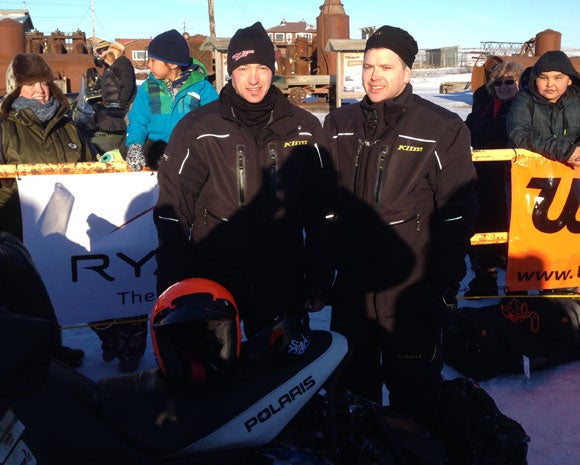


 Your Privacy Choices
Your Privacy Choices